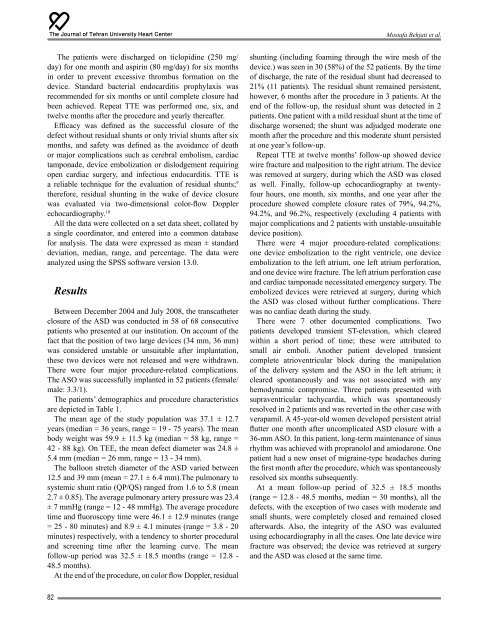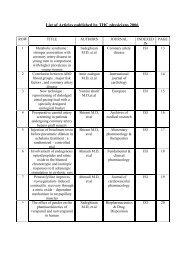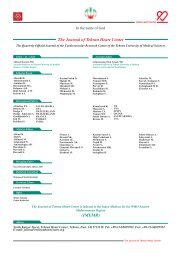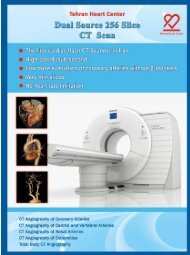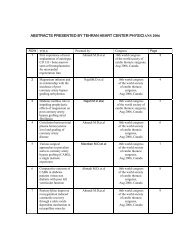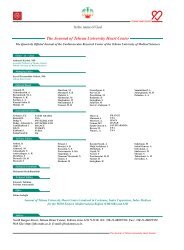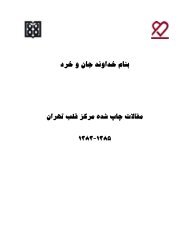Journal of Tehran University Heart Center
Journal of Tehran University Heart Center
Journal of Tehran University Heart Center
You also want an ePaper? Increase the reach of your titles
YUMPU automatically turns print PDFs into web optimized ePapers that Google loves.
The <strong>Journal</strong> <strong>of</strong> <strong>Tehran</strong> <strong>University</strong> <strong>Heart</strong> <strong>Center</strong><br />
The patients were discharged on ticlopidine (250 mg/<br />
day) for one month and aspirin (80 mg/day) for six months<br />
in order to prevent excessive thrombus formation on the<br />
device. Standard bacterial endocarditis prophylaxis was<br />
recommended for six months or until complete closure had<br />
been achieved. Repeat TTE was performed one, six, and<br />
twelve months after the procedure and yearly thereafter.<br />
Efficacy was defined as the successful closure <strong>of</strong> the<br />
defect without residual shunts or only trivial shunts after six<br />
months, and safety was defined as the avoidance <strong>of</strong> death<br />
or major complications such as cerebral embolism, cardiac<br />
tamponade, device embolization or dislodgement requiring<br />
open cardiac surgery, and infectious endocarditis. TTE is<br />
a reliable technique for the evaluation <strong>of</strong> residual shunts; 9<br />
therefore, residual shunting in the wake <strong>of</strong> device closure<br />
was evaluated via two-dimensional color-flow Doppler<br />
echocardiography. 10<br />
All the data were collected on a set data sheet, collated by<br />
a single coordinator, and entered into a common database<br />
for analysis. The data were expressed as mean ± standard<br />
deviation, median, range, and percentage. The data were<br />
analyzed using the SPSS s<strong>of</strong>tware version 13.0.<br />
Results<br />
Between December 2004 and July 2008, the transcatheter<br />
closure <strong>of</strong> the ASD was conducted in 58 <strong>of</strong> 68 consecutive<br />
patients who presented at our institution. On account <strong>of</strong> the<br />
fact that the position <strong>of</strong> two large devices (34 mm, 36 mm)<br />
was considered unstable or unsuitable after implantation,<br />
these two devices were not released and were withdrawn.<br />
There were four major procedure-related complications.<br />
The ASO was successfully implanted in 52 patients (female/<br />
male: 3.3/1).<br />
The patients’ demographics and procedure characteristics<br />
are depicted in Table 1.<br />
The mean age <strong>of</strong> the study population was 37.1 ± 12.7<br />
years (median = 36 years, range = 19 - 75 years). The mean<br />
body weight was 59.9 ± 11.5 kg (median = 58 kg, range =<br />
42 - 88 kg). On TEE, the mean defect diameter was 24.8 ±<br />
5.4 mm (median = 26 mm, range = 13 - 34 mm).<br />
The balloon stretch diameter <strong>of</strong> the ASD varied between<br />
12.5 and 39 mm (mean = 27.1 ± 6.4 mm).The pulmonary to<br />
systemic shunt ratio (QP/QS) ranged from 1.6 to 5.8 (mean<br />
2.7 ± 0.85). The average pulmonary artery pressure was 23.4<br />
± 7 mmHg (range = 12 - 48 mmHg). The average procedure<br />
time and fluoroscopy time were 46.1 ± 12.9 minutes (range<br />
= 25 - 80 minutes) and 8.9 ± 4.1 minutes (range = 3.8 - 20<br />
minutes) respectively, with a tendency to shorter procedural<br />
and screening time after the learning curve. The mean<br />
follow-up period was 32.5 ± 18.5 months (range = 12.8 -<br />
48.5 months).<br />
At the end <strong>of</strong> the procedure, on color flow Doppler, residual<br />
Mostafa Behjati et al.<br />
shunting (including foaming through the wire mesh <strong>of</strong> the<br />
device.) was seen in 30 (58%) <strong>of</strong> the 52 patients. By the time<br />
<strong>of</strong> discharge, the rate <strong>of</strong> the residual shunt had decreased to<br />
21% (11 patients). The residual shunt remained persistent,<br />
however, 6 months after the procedure in 3 patients. At the<br />
end <strong>of</strong> the follow-up, the residual shunt was detected in 2<br />
patients. One patient with a mild residual shunt at the time <strong>of</strong><br />
discharge worsened; the shunt was adjudged moderate one<br />
month after the procedure and this moderate shunt persisted<br />
at one year’s follow-up.<br />
Repeat TTE at twelve months’ follow-up showed device<br />
wire fracture and malposition to the right atrium. The device<br />
was removed at surgery, during which the ASD was closed<br />
as well. Finally, follow-up echocardiography at twentyfour<br />
hours, one month, six months, and one year after the<br />
procedure showed complete closure rates <strong>of</strong> 79%, 94.2%,<br />
94.2%, and 96.2%, respectively (excluding 4 patients with<br />
major complications and 2 patients with unstable-unsuitable<br />
device position).<br />
There were 4 major procedure-related complications:<br />
one device embolization to the right ventricle, one device<br />
embolization to the left atrium, one left atrium perforation,<br />
and one device wire fracture. The left atrium perforation case<br />
and cardiac tamponade necessitated emergency surgery. The<br />
embolized devices were retrieved at surgery, during which<br />
the ASD was closed without further complications. There<br />
was no cardiac death during the study.<br />
There were 7 other documented complications. Two<br />
patients developed transient ST-elevation, which cleared<br />
within a short period <strong>of</strong> time; these were attributed to<br />
small air emboli. Another patient developed transient<br />
complete atrioventricular block during the manipulation<br />
<strong>of</strong> the delivery system and the ASO in the left atrium; it<br />
cleared spontaneously and was not associated with any<br />
hemodynamic compromise. Three patients presented with<br />
supraventricular tachycardia, which was spontaneously<br />
resolved in 2 patients and was reverted in the other case with<br />
verapamil. A 45-year-old women developed persistent atrial<br />
flutter one month after uncomplicated ASD closure with a<br />
36-mm ASO. In this patient, long-term maintenance <strong>of</strong> sinus<br />
rhythm was achieved with propranolol and amiodarone. One<br />
patient had a new onset <strong>of</strong> migraine-type headaches during<br />
the first month after the procedure, which was spontaneously<br />
resolved six months subsequently.<br />
At a mean follow-up period <strong>of</strong> 32.5 ± 18.5 months<br />
(range = 12.8 - 48.5 months, median = 30 months), all the<br />
defects, with the exception <strong>of</strong> two cases with moderate and<br />
small shunts, were completely closed and remained closed<br />
afterwards. Also, the integrity <strong>of</strong> the ASO was evaluated<br />
using echocardiography in all the cases. One late device wire<br />
fracture was observed; the device was retrieved at surgery<br />
and the ASD was closed at the same time.<br />
82


